In collaboration with the Young Audience for Houston – Arts for Learning.



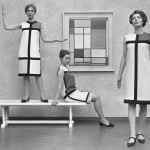
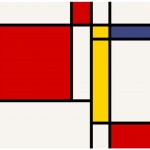
The Art of Piet Mondrian CBS Sunday Morning News 10/1/2017
Piet Mondrian was one of the greatest painters and the leading abstract artist of the 20th century. His abstract art consisted of white ground, upon which he painted a grid of vertical and horizontal black lines and the three primary colors. De Stijl, Dutch for “The Style” was a Dutch artistic movement founded in 1917 in Amsterdam. He is still “Pulsating Intricacy” as can be felt in this 2015 NY times article.
Can you solve the Mondrian Art Riddle?
Now Code your Style with The Artist or whatever language inspires you!
OBJECTIVE: Introduce important ideas in art that use simple geometric forms. Our art project will be to create your own version of the 1921 Composition II in Red, Blue, and Yellow art masterpiece.

EXAMPLES:
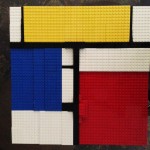
… Richard Kerver 3D Lego Creation
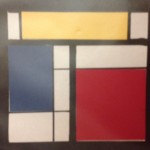

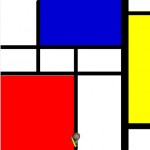 Run the Blockly Code in Code Studio
Run the Blockly Code in Code Studio
… First Plan the Design with Construction paper – Lesson by Liz Spencer
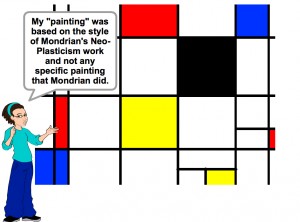 Scratch Studio by Vicky Sedgwick Southern California
Scratch Studio by Vicky Sedgwick Southern California


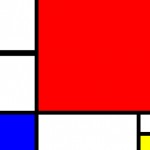 Run the Text-based Code in WeScheme
Run the Text-based Code in WeScheme
… Pin Oak MS Mondrian Art in WeScheme by Pamela Ossorio.
 Programmed in Khan Academy by Kate Fractal
Programmed in Khan Academy by Kate Fractal
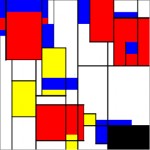 … Finnish Mondrian Art in Racket Turtle by Tiina Partanan
… Finnish Mondrian Art in Racket Turtle by Tiina Partanan
…. See More Graphics from Finland
- Random Mondrian Art Generator in Processing – Find one you like?
- Examples are key – Processing Mondrian Composition
CODING GOALS:
- Master drawing black lines of various widths using move and turn commands.
- Master drawing blue, yellow and red solid rectangles of various sizes using the loop command.
- Using your plan, combine lines and rectangles to create your Mondrian Art piece.
PROCESS:
- Plan your Mondrian Art piece.
- Design with construction paper or makers. See the unplugged lesson below.
- Trace the art design on transparency paper.
- Plot the corner points and calculate size of rectangles.
- Watch the artist intro video.
- Practice using line tools in Code Studio Course 2 Stage 4.
- Create a drawing with vertical and horizontal black lines in Free Play.
- What size is the canvas in pixels?
- What degree is the angle you use when turning?
- How do you change the width of the line?
- Observe and develop ideas from an example.

- Practice using loop tools in Code Studio Course 2 Stage 7.
- Create a drawing with red, blue and yellow solid rectangles in Free Play.
- Is a square a rectangle?
- What pattern do you see that varies the size of the rectangle?
- How do you determine if you turn right or left?
- Observe patterns and use your spatial reasoning to create rectangles.

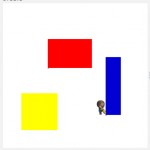

- Does coding make it easier to play with color choice?
- Now that you have mastered using the coding tools, you need to revisit your project plan you created with construction paper. Using the 20 pixel graph paper, overlap transparency paper on your design. Re-draw the pattern adjusting lines as needed. Plot the corner points and calculate the length of each side of the rectangle.
- Code the rectangles first. You need to repeat lines to create a solid shape. The code the black lines. This requires perseverance, as the artist starts drawing where left off so requires some thinking math.
UNPLUGGED CONSTRUCTION PAPER LESSON
Materials
- Rag translucent marker paper or heavy duty tracing paper (suitable for markers) 8.5 x 11”
- Grid Template with X axis and Y axis marked
- Construction Paper (red, yellow, blue and black)
- Black Sharpie markers
- Tape
- Scissors or paper cutter
- Glue stick or liquid glue
Process:
- Tape the translucent paper over the grid template.
- Cut rectangles and squares of different sizes from the red, blue, black and yellow paper. Cut at least one shape from each primary color.
- Arrange the shapes you cut into a pleasing composition: Leave some areas white.
- Separate the different shapes with black lines around each shape, drawn with the marker or cut from the black paper.
Consider how you want your eye to follow the colors and how you might create a balance in their placement. Keep in mind you may wish to create an asymmetrical composition.” To reinforce comprehension of fractions, have the students cut dimensional rectangles and squares, that is squares that are one-half the size of the first one they cut, or rectangles twice the size of the first one cut.
VOCABULARY
• Composition: The way the parts of the artwork are arranged by the artist.
• Abstract Art: Art that is either a stylized impression of what the artist saw or non-representational art that is completely detached from the things that we see including only lines, shapes, colors, and textures.
• Primary Colors: A fundamental color from which all other colors can be made by mixing.
• Geometric: Using shapes with straight lines, circles, squares or parts formed thereof
• Asymmetric: Not the same on both sides; not a mirror image
• Cubism: An art style which fragments forms and space
ABOUT Piet Mondrian:
Piet Mondrian was a Dutch painter who created a geometrical abstract style known as neoplasticism. It had widespread influence on modern painting, architecture and design. He was born in 1872 and went to art school in Amsterdam where he began painting meadows, farms, cows and windmills. He studied and tried different art styles before his experiments in cubism. These experiments led him to develop its ideas even further, and he gradually eliminated all figures and subjects from his paintings.
He met other Dutch painters Bart van der Leck and Theo van Doesburg and with them founded an influential new movement called De Stijl or The Style. His work after this time evolved to compositions divided into rectangles of different sizes, each painted a uniform color. He moved to the use of the three primary colors because with white and black he felt they represented the strongest, purest contrasts. In most of his compositions, he divided his pictures asymmetrically with a grid of black vertical and horizontal lines, painting in some of the resulting rectangles with yellow, blue, red or black. White became an important grounding element in his paintings. He broke ties with DeStijl in 1925 when his friend Van Doesburg started to use diagonal lines.
He lived in Paris from 1919 to 1938 and in London from 1938 to 1940. He moved to New York where his work was influenced by the city and by the music form jazz. He died in New York in 1944.
APPLICATION THINKING
Mondrian worked realistically early in his career, then experimented with various styles. He liked the fact that cubism allowed him to change shapes and space, and he eventually settled on the style we saw in the art example.
- Now that you have created a work of art in the style of Mondrian, can you relate more examples of this style in our everyday lives?
- Can you think of ways that artists might further reduce the visual information they use in artwork?
- What might the artists be saying in these works?
- How might they be considered to be fine art?
- Fashion, Data Science and Agriculture – how do they come together?
RESEARCH and EXTEND IDEAS
In addition to Mondrian and Van Doesburg, some of these influential artists include:
• Kazimir Malevich (founder of the very structured Suprematism movement)
• Josef Albers (influential painter and color theorist)
• Stanley Whitney (contemporary painter working in New York City)
• Mark Rothko (minimalist painter, smudged geometric compositons)
• Bridgit Riley (op art painter using geometric forms to create movement and tension)
• The Gee Bend Quilters (rural Alabama women using brilliant quilted geometrics)
• John Biggers (muralist and printmaker who combined figures with “sacred geometry”)
• Kenneth Noland (painter known for his circles and color theories)
• Frank Stella (influential modernist who shaped canvases with geometric themes)
• Barnett Newman (minimalist geometric painter and sculptor)
• Donald Judd (minimalist geometric sculptor)
• Agnes Martin (minimalist abstract painter)
• Dan Flavin (neon and lighting pioneer)